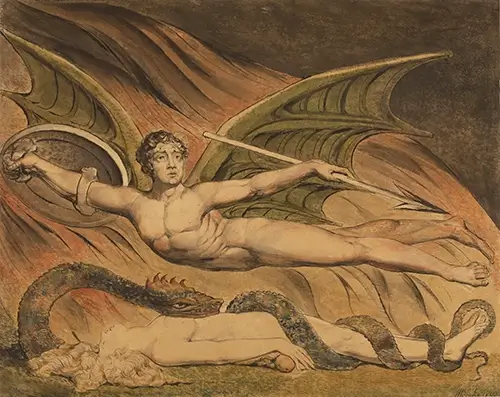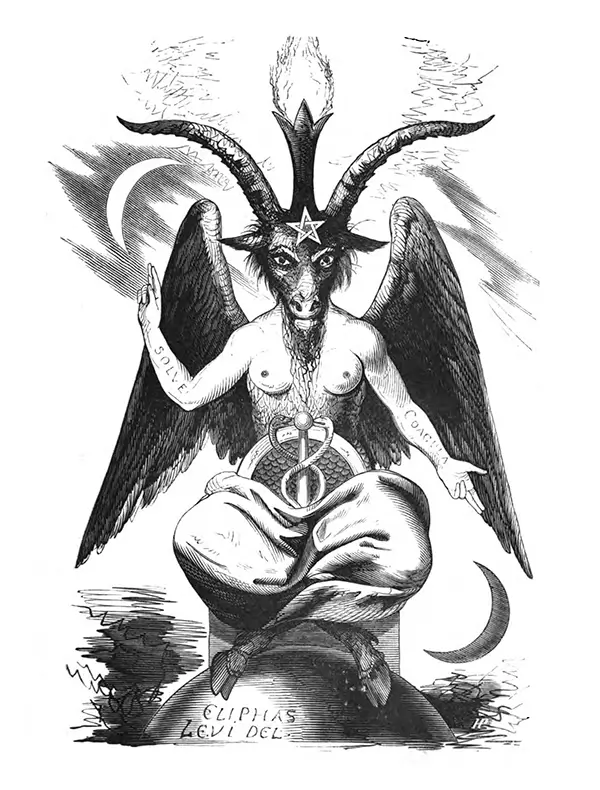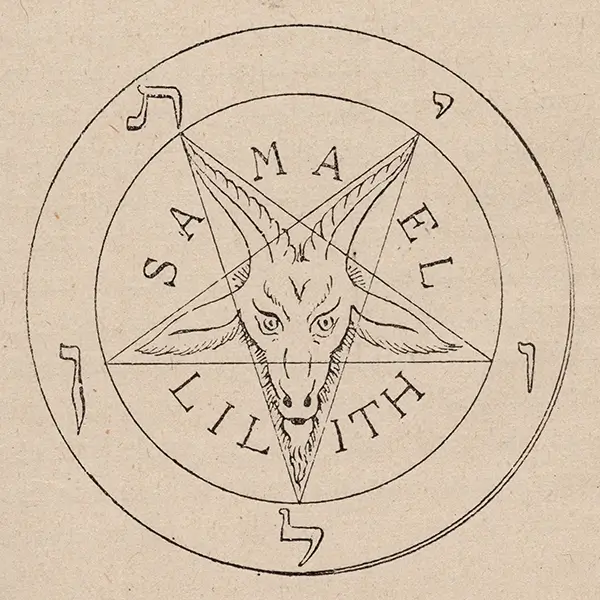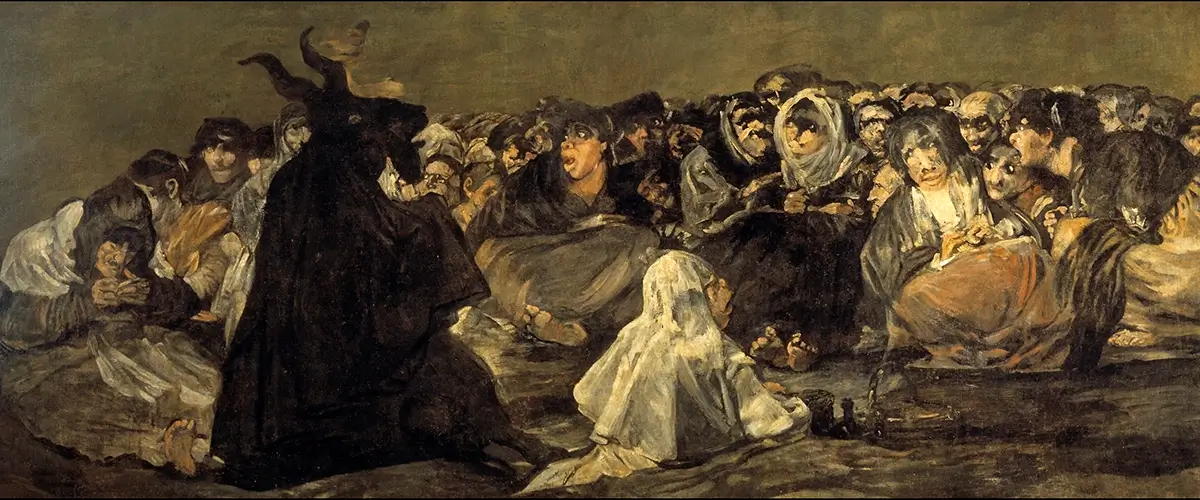Personal note from site admin:
Ave Satanas! And so we’ve arrived to one of my favourite topics! Satanism is close to my heart. It’s got me through some tough times in the past and, although I don’t specifically practise, some of the overarching values have stuck in my mind.
When something ugly raises its head (depression, anxiety, those things) some of the concepts of Satanism such as those related to personal empowerment and pleasure, and even some of its symbolisms, are something that often take the edge off of things.
Maybe more about that later.
Overview of Satanism
First of all: who is Satan?
Satan is a prominent figure in Abrahamic religions, such as Christianity, Judaism, and Islam, commonly depicted in Christianity as a fallen angel or demon who opposes God and is associated with temptation and evil. He tempts humans into sin. While in Judaism, Satan is viewed more as an adversary or prosecutor, in Islam, he is a also a tempter, known as Iblis.
Some other names for Satan include Lucifer, the Devil and the Father of Lies.

(Photo credit: William Blake, Public domain, via Wikimedia Commons)
Definition of Satanism
For example in the Cambridge Dictionary or the Collins Dictionary, the definition of satanism is depicted simply as “the worship of Satan”. Of course, this is a much more simplified way of explaining what it is than the actual robust concept of Satanism, especially in the modern times. I can imagine many people sighing in annoyance, reading the dictionary definition. Not to mention the “synonyms” below – talk about negative connotations!
The pronunciation of the word “satanism” using the IPA (International Phonetic Alphabet) is written out like this: /ˈseɪ.tən.ɪ.zəm/
A quick look in the thesaurus and you can find several words depicted as synonyms for satanism, for example:
- witchcraft
- black arts
- demon worship
- demonianism (that’s an interesting one!)
- mysticism
- voodoo
- necromancy
- sorcery
- wizardry
- diabolism
You don’t often see demonianism, or at least I haven’t. So I had to check it out. It can mean two things: 1) the belief in demon possession, or 2) the state of being possessed by a demon. Huh, learned something new today.
Looking at the synonyms above, for example “diabolism” and “demon worship” – these are interesting ones considering that the majority of satanists are actually not “demon worshippers”. Diabolism means the same – worship of the Devil. It’s no wonder that there are so many misconceptions about satanism out there.
10 common beliefs and principles of Satanism
What do satanists believe in? What are some of their core beliefs? There are many of these across the different satanic organisations and groups. Here we mainly look at those from Atheistic groups.
Here are 10 common beliefs and principles of Satanism:
- Strong rejection of “traditional” religious concepts such as the belief in gods, angels and other supernatural beings
- Emphasis on individualism, personal autonomy, self-empowerment and determination
- Critical thinking, rationality and empirical/scientific evidence is valued over blind faith or some sort of dogma
- Pursuit of knowledge and personal growth and self-improvement
- Valuing sexuality, pleasure and otherwise celebrating the carnal and physical aspects of human existence
- Respect of the natural world and not harming any living being, including both humans and animals
- Opposing authoritarianism, oppression and censorship
- Rejection of the concept of sin and the need for salvation – instead, everyone is responsible for themselves
- Emphasis on aesthetics, creativity and individual expression of different forms of culture
- Belief in social justice, equality and human rights, and opposing of discrimination based on race, gender, sexuality or any other personal characteristic
Different types of Satanism
Atheistic Satanism
A question that often arises, (rather annoyingly, if I may say so), is “Do satanists worship the Devil?” Most often than not, a satanist is an atheist, which means they don’t believe in any god or devil.
Atheistic Satanism is a religious movement that involves no worship. There is no belief in the actual Satan as a being, but more in the ideals that Satan represents, such as challenging (tyrannical, arbitrary) authority, questioning the status quo and fighting for justice and personal sovereignty.
This is how the Church of Satan, one of the most well-known satanic organisations today, describe their view of Satan:
Satan to us is a symbol of pride, liberty and individualism, and it serves as an external metaphorical projection of our highest personal potential. We do not believe in Satan as a being or person.
The Church of Satan Tweet
When asked “do you worship Satan?” from the Satanic Temple, another well-known satanic organisation, their answer is:
No, nor do we believe in the existence of Satan or the supernatural. [...] To embrace the name Satan is to embrace rational inquiry removed from supernaturalism and archaic tradition-based superstitions.
The Satanic Temple Tweet
Theistic Satanism
In contrast to Atheistic Satanism, Theistic Satanism considers Satan to actually exist as a deity or entity to be worshipped.
Theistic Satanism generally involves rituals and devotional acts to honour and communicate with Satan, as well as the pursuit of personal empowerment and spiritual enlightenment through Satan’s teachings. Some theistic Satanists also incorporate elements of other occult or esoteric traditions into their practice, such as forms of magic.
Theistic Satanism is not as common as atheistic Satanism.
Personal or Individual Satanism
Some people choose to incorporate beliefs, tenets and other elements from various satanic organisations, based on what works for them individually, rather than strictly adhering to one organisation or another.
It’s an individualistic approach to Satanism that emphasises personal beliefs in a unique “bundle” tailored to a person’s needs and preferences, so that it resonates with their own unique world view. People might also develop a personal philosophy, their own rituals and practises, based on various existing principles.
Basically, if you don’t like an aspect of, let’s say the Satanic Temple (just an example), you just disregard that aspect but follow the rest, rather than abandoning everything altogether. And you might incorporate some tenets from the Church of Satan (just another example).
This is a bit of a murky one, as Personal Satanism is not really an official term for a type of Satanism – it’s included here as it’s an interesting concept nonetheless.
Well-known Satanic organisations
The Satanic Temple
The Satanic Temple is a atheistic Satanic organisation that promotes social and political activism. It advocates for the separation of church and state, and has been involved in several high-profile campaigns, including efforts to erect a Satanic monument on public property and to challenge the use of religious exemptions to discriminate against LGBTQ+ individuals. Lately, they have been heavily advocating for abortion rights in the U.S.
For them, Satan is a symbol of the “eternal rebel” in the face of arbitrary authority. They have 7 tenets that guide their beliefs and world view, and help inspire “nobility in action and thought.”
The Satanic Temple is the only Satanic religious organisation in the U.S. that’s recognised as a church.
The mission of the Satanic Temple is to encourage benevolence and empathy, reject tyrannical authority, advocate practical common sense, oppose injustice, and undertake noble pursuits.
The Satanic Temple Tweet
The Church of Satan
Founded by Anton LaVey in 1966, the Church of Satan is one of the oldest and most well-known Satanic organisations. It emphasises individualism, rationality, and skepticism, and sees Satan as a symbol of human potential and freedom.
The Church of Satan follows LaVeyan Satanism, described in their central religious text, the Satanic Bible, which also outlines their 9 Satanic statements. The members of the church follow a system of degrees based on merits awarded from demonstrating their skills in Satanic Theory, as well as personal achievements in the outside world.
We stand in opposition to theist religions and their inherent hypocrisy. We are a formidable threat to any who would halt progress in the name of spirituality. We are explorers on the untrodden paths of science, human motivation and all mysteries awaiting understanding—that which is most truly “occult.”
The Church of Satan
The church of satan vs The Satanic Temple - main differences
These are the two biggest Satanic organisations in the world. The Satanic Temple has its own guiding principles that differ from the beliefs of the LaVeyan school of Satanism. The Satanic Temple emphasises rational decision making using scientific evidence, while rejecting “social Darwinism and authoritarianism” which it feels the Church of Satan is about.
Unlike LaVeyan Satanism, The Satanic Temple doesn’t believe in supernatural theories of the universe and does not value LaVeyan edicts related to the acknowledgment of magic. The Satanic Temple sees these differences as a natural evolution in Satanic thought.
While both organisations embrace values such as individualism and personal empowerment, they approach activism in different ways. The Satanic Temple is known for its high-profile activism and advocacy efforts, using Satanism as a tool to challenge religious privilege, promote social justice, and defend the separation of church and state.
A recent example of this is their fundraising work towards abortion rights in the U.S., and having set up a free abortion care clinic in New Mexico in response to the ever-tightening abortion laws in the United States.
The Church of Satan, on the other hand, emphasises individualism and personal exploration, focusing less on political or social activism.
The Church of Satan incorporates (atheistic, symbolic) rituals, magic and other occult practises into its world view, whereas the Satanic Temple doesn’t, although they don’t discourage their members from practising different kinds of rituals (e.g. Black Mass) if they find them personally meaningful.
The Temple of Set
Founded by Michael Aquino in 1975, the Temple of Set is an occult religious movement that focuses on ritual magic and the exploration of the self. It is named after the Egyptian god Set, who is seen as a symbol of individuality and rebellion.
Their religion is called Setianism, and they are often seen as a Satanic organisation, although there is some debate whether or not that’s actually the case. Some call their form of Satanism “Esoteric Satanism”. Their founder used to belong to the Church of Satan, and founded the Temple of Set after realising that Satan is actually the one true god, named Set.
The Church of Rational Satanism
The Church of Rational Satanism is a Satanic organisation that emphasises rationality, skepticism, and individualism. It is an atheistic organisation that rejects the existence of supernatural entities and focuses on the pursuit of personal growth and self-determination. They were established in 2009 by Lee Banks.
They have a system of personal growth, a ladder that they call “the 8 Satanic cognitive realms.” Their members are encouraged to follow an individualistic path based on what works for them personally, as long as it follows the core principles of the organisation. They have 14 different averments that list their core principles.
Evolution of the mind leads to evolution of knowledge, and that is the path of success.
The Church of Rational Satanism Tweet
The Sect of the Horned God
The Sect of the Horned God is a Satanic organisation that emphasises the following of Satan as “the self”, the human is the beast to be “worshipped”, and the Horned God symbolises this and the natural world surrounding everything.
The Sect of the Horned God describes itself as an occult educational foundation with a Left-Hand Path philosophy, where, rather than worshipping any supernatural beings, they value the analytical study of philosophy, psychology, mythology and the occult.
Why is Satanism often viewed negatively?
Dark imagery and the rejection of traditional religious beliefs
Satanism is often seen as a sinister and dangerous movement due its association with dark imagery, its rejection of traditional religious beliefs, and its controversial history. These have formed into a frustrating stereotype which many movies and other media sadly still tend to repeat today.
Satanism has long been associated with dark imagery and practices, including black magic, ritual sacrifice, and other forms of taboo-breaking behaviour (just look at the list of “synonyms” for Satanism listed in any thesaurus). These associations have been emphasised in popular culture, where Satanists are often depicted as sinister and malevolent, dark hooded figures that do shady things at night.
Because Satanism rejects traditional religious beliefs and practices, it is often viewed with suspicion and even hostility by mainstream society. Many people associate Satanism with evil or immorality, and see it as a threat to their own religious beliefs.
Satanic ritual abuse and the Satanic Panic
In the past, there have been a few individuals and groups who have identified as Satanists and engaged in criminal or violent behaviour. For example, the serial killer Richard Ramirez, also known as the Night Stalker, said he was acting as the right hand man of Satan and had a strong interest in Satanism and the occult.
It was widely discussed in the media. This and some other isolated incidents have fuelled baseless fears and conspiracy theories about the supposed danger of Satanism, even though Satanists reject violence as a core tenet of their philosophy.
The Satanic Panic was a moral panic phenomenon that swept across the world, starting in the United States in the early 1980s and spreading to wider parts of the world by the 1990s. There were thousands of unsubstantiated cases of satanic ritual abuse, accusing people and organisations of rituals involving physical and sexual abuse, often of children.
There was also a widespread conspiracy theory that a vast underground network of Satanists, consisting of wealthy and influential individuals, was operating in secret and engaging in child sexual abuse, human sacrifice, the production of snuff films and other criminal activities.
The Satanic panic was fuelled by sensationalistic media coverage and claims made by individuals, self-claimed “experts” of the occult. Any subsequent investigations by law enforcement and researchers failed to find any evidence of such a network, or individual cases. This moral panic faded by the mid-1990s, but it had a lasting impact especially in popular culture.
Common symbols in Satanism
The Satanic Goat
The Satanic Goat is also known as Baphomet, or the Sabbatic Goat. It’s often depicted as a goat-headed figure with wings, a pentagram on its forehead, and various other esoteric symbols in different places of the image.
The history of the symbol is associated with the 19th century French occultist Eliphas Levi, who used it in his ceremonial magic system. In his writings, Levi described the goat as a representation of the union of opposites, with the goat’s horns symbolising masculine energy and the goat’s breasts representing feminine energy.
The symbol has been adopted by various occult groups over the years, including groups associated with Satanism. This is why it’s often called the Satanic Goat. A famous example is the large Baphomet statue at the Satanic Temple headquarters.

The sigil of Baphomet
The Sigil of Baphomet has an inverted pentagram with the head of Baphomet, or the Satanic Goat, inside it. The goat head is often depicted as having a pentagram on its forehead in the newer versions of the design (such as that of the official insignia of the Church of Satan).
The original pentagram (pictured below) has letters in Hebrew around it in a circle, at the five points of the pentagram. The letters spell out Leviathan, the ancient serpent sometimes identified with Satan in Christian theology.

(Image credit: Stanislas de Guaita (1861–1897), Public domain, via Wikimedia Commons)
The cross of Saint Peter
The cross of Saint Peter, also known as the inverted cross, or the Petrine cross. In Christianity, it’s associated with Peter the Apostle, but is nowadays known as an occult symbol to signify anti-Christian or Satanic views.

The sigil of Lucifer
The Sigil of Lucifer is also known as the Seal of Satan (what a great alliterative name!). In ritual magic, either for real in theistic versions of Satanism or symbolically, it can be used to call forth Satan.

The Leviathan Cross
The Leviathan cross is also known as Satan’s cross, or the sulfur cross. This comes from alchemy – the symbol was originally used as one of the alchemical symbols representing sulfur, which in turn represents the fire and brimstone of hell.

Satanic numbers
666 and 616
666 is a symbol that appears in the Book of Revelation in the Christian Bible. It is traditionally associated with the Antichrist or the devil, and is often used as a symbol of evil or bad luck. It’s also known as the number of the beast.
The exact meaning of the number 666 is debated among scholars and theologians. Some interpret it as a reference to a specific historical figure, while others see it as a more general symbol of evil or imperfection. In popular culture, the number 666 is often used as a reference to the devil or demonic entities, and has become a widely recognised symbol of evil.
The validity of the number 666 as the number of the beast or antichrist, has recently been questioned, when a fragment of the oldest surviving copy of the New Testament was discovered in Egypt. It indicates that the original number was 616.
References and further reading
- The Satanic Temple official website
- The Satanic Temple: Abortion Clinic Fundraiser – The Satanic Temple
- The Church of Satan official website
- The Temple of Set official website
- The Church of Rational Satanism official website
- The Sect of the Horned God official website
- Dyrendal, Asbjorn, James R. Lewis, and Jesper Aa. Petersen, The Invention of Satanism (New York, 2015; online edn, Oxford Academic, 19 Nov. 2015)
- van Luijk, Ruben, ‘The Christian Invention of Satanism‘, Children of Lucifer: The Origins of Modern Religious Satanism (New York, 2016; online edn, Oxford Academic, 23 June 2016)
- Devil’s advocate: are satanists now the good guys in the fight against the evangelical right? – The Guardian
- Satanism – HISTORY
- It’s Time to Revisit the Satanic Panic – The New York Times
- Revelation! 666 is not the number of the beast (it’s a devilish 616) – Independent

